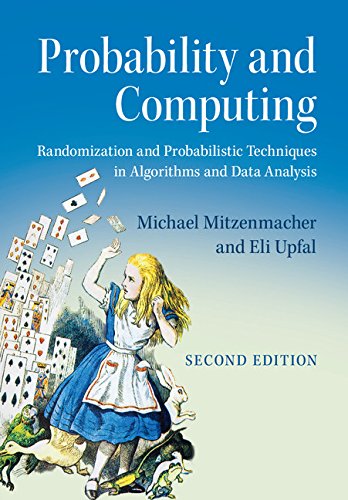
Ebook Info
- Published: 2017
- Number of pages: 489 pages
- Format: PDF
- File Size: 5.79 MB
- Authors: Michael Mitzenmacher
Description
Greatly expanded, this new edition requires only an elementary background in discrete mathematics and offers a comprehensive introduction to the role of randomization and probabilistic techniques in modern computer science. Newly added chapters and sections cover topics including normal distributions, sample complexity, VC dimension, Rademacher complexity, power laws and related distributions, cuckoo hashing, and the Lovasz Local Lemma. Material relevant to machine learning and big data analysis enables students to learn modern techniques and applications. Among the many new exercises and examples are programming-related exercises that provide students with excellent training in solving relevant problems. This book provides an indispensable teaching tool to accompany a one- or two-semester course for advanced undergraduate students in computer science and applied mathematics.
User’s Reviews
Reviews from Amazon users which were colected at the time this book was published on the website:
⭐Very interesting topic.the explanationsare are thorough and even if one forgot some of the basics he can understand the proofs of the theorems and lemma’s.
⭐One of my favorite textbook. All the concepts are explained clearly and motivated with very interesting examples.Also, I think this textbook is a great way to learn about probability for someone with a computer science background.
⭐A very good book
⭐Ich beschäftige mich in letzer Zeit mit einem Twitter-Bot namens Vanellus. Vanellus lädt alle Deutschsprachigen Tweets (ca. 1Million/Tag) herunter und man kann alle möglichen Analysen der Daten durchführen. Für derartige Analysen braucht man keine exakten Algorithmen. Ich wollte mich daher näher mit der Frage beschäftigen, wie man mit Probabilistic Algorithms den Berechnungen beschleunigen kann. Für diesen Zweck war das Buch ein schlechter Kauf. Die Autoren beschreiben ihr Konzept wie folgt:”We have taken the view that, in order to best apply and understand the strengths and weaknesses of heuristic methods, a firm grasp of underlying probability theory and rigorous techniques – as we present in this book – is necessary. We hope that students will appreciate this point of view by the end of the course”.Nachdem ich mathematische Stastitik studiert habe, muss ich den ersten Teil nicht mehr lernen. Wenn ich einen Algo für die Lösung eines Problems suche, sind mir die Beweise ziemlich egal. Ich will möglichst genau wissen wie er geht und für welche Probleme er geeignet ist. Ich will selbst nicht einen Algo publizieren, sondern ein Programm schreiben, dass ein Problem löst. Es kommen im Buch sehr viele mathematischen Symbole, jedoch kein (Pseudo-)Kode von Algorithmen vor.Es sind viele dieser Beweise praktisch irrelevant. Z.B. ist das Traveling-Salesman Problem theoretisch NP-hard. Es gibt jedoch Algorithmen, die erstaunlich effektiv sind. Die Pathologischen Fälle die das Problem explodieren lassen interessieren einem nicht bzw. man lässt in diesem Fall einen anderen heuristischen Algo laufen.Ein Beispiel für die Irrelevanz derartiger Überlegungen liefert das Buch selbst. Die Autoren lieben das von ihnen entwickelte “Cuckoo Hashing”. Man löst Hash-Kollisionen auf, indem man den neuen Wert abspeichert und den alten Wert mit einer anderen Hash-Funktion an einer neuen Stelle speichert. Der neue Wert wirft quasi den alten aus dem Nest. Der alte Wert kann an der neuen Stelle wieder einen Wert aus dem Nest werfen. Das Spiel setzt sich solange fort, bis ein noch nicht besetztes Nest gefunden wird. Es lässt sich mathematisch zeigen, dass diese Methode weniger runs erzeugt, die Tabelle zufälliger anfüllt, als simple lineare Kollisonsauflösung (man sucht linear die erste freie Stelle). Praktisch gesehen ist jedoch die einfache, lineare Methode wesentlich besser. Die lineare Methode ist Cache-freundlich, die Kuckucks-Methode erzeugt systematisch Cache-misses. Aber so was kommt in der Welt der Mathematiker die nicht direkt programmieren nicht vor.Die Bewertung des Buches hängt von den Erwartungen ab. Im Sinne der theoretischen Informatik verdient es 5-Sterne, aus praktischer Sicht (wie oben beschrieben) ist es wenig brauchbar. Man könnte auch argumentieren, dass ich beim Kauf nicht genau geschaut habe und nun nicht zu lamentieren brauche. Was können brillante Mathematiker dafür dass die Sau mit ihren Perlen nix anzufangen weiss.Excellent book with an interesting set of examples for use in probability and computer science.
Keywords
Free Download Probability and Computing: Randomization and Probabilistic Techniques in Algorithms and Data Analysis 2nd Edition in PDF format
Probability and Computing: Randomization and Probabilistic Techniques in Algorithms and Data Analysis 2nd Edition PDF Free Download
Download Probability and Computing: Randomization and Probabilistic Techniques in Algorithms and Data Analysis 2nd Edition 2017 PDF Free
Probability and Computing: Randomization and Probabilistic Techniques in Algorithms and Data Analysis 2nd Edition 2017 PDF Free Download
Download Probability and Computing: Randomization and Probabilistic Techniques in Algorithms and Data Analysis 2nd Edition PDF
Free Download Ebook Probability and Computing: Randomization and Probabilistic Techniques in Algorithms and Data Analysis 2nd Edition